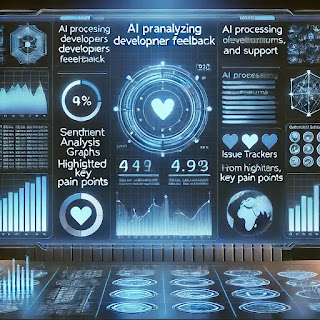How AI Helps You Stay Ahead of Developer Trends
Understanding and addressing developer pain points is crucial for businesses that rely on developer engagement. However, tracking, analyzing, and acting on developer concerns can be challenging due to scattered feedback, evolving trends, and the sheer volume of discussions across platforms. This is where AI-powered analysis plays a game-changing role.
The Challenges of Identifying Developer Pain Points
Developers constantly interact with documentation, APIs, and support systems, but not all challenges are immediately visible. Some of the biggest hurdles in identifying developer pain points include:
- Scattered Feedback Sources – Developers share feedback across forums, GitHub issues, support tickets, and social media, making it difficult to track patterns.
- Time-Consuming Manual Analysis – Sorting through discussions manually takes significant effort and often results in missed insights.
- Rapidly Evolving Trends – Developer needs shift frequently as technology evolves, requiring continuous monitoring.
- Unclear Sentiment and Prioritization – Not all feedback is explicit; some frustrations may go unnoticed without deeper analysis.
Traditional methods of collecting feedback often fail to provide the depth of insight needed to make meaningful improvements. AI changes this by automating data collection, categorization, and sentiment analysis to deliver actionable insights.
How AI Transforms Developer Feedback Analysis
AI-powered tools can process vast amounts of developer feedback in real time, providing a clear picture of common pain points. Here’s how AI makes this possible:
1. Automating Feedback Collection
AI tools aggregate developer concerns from multiple sources, including:
- Community forums and social media – AI scrapes public discussions and detects recurring issues.
- GitHub and issue trackers – AI monitors bug reports, feature requests, and developer comments.
- Support tickets and chat logs – AI identifies patterns in help desk interactions.
- API usage and performance data – AI flags areas where developers struggle with implementation.
2. Sentiment and Trend Analysis
Using Natural Language Processing (NLP), AI can:
- Detect developer frustration and confusion through sentiment scoring.
- Identify trending issues based on the volume of discussions.
- Highlight frequently requested improvements to prioritize development efforts.
3. Predictive Insights and Actionable Recommendations
Beyond tracking existing concerns, AI can predict future pain points by:
- Analyzing historical patterns to foresee recurring issues.
- Anticipating API or tool adoption challenges before they escalate.
- Recommending documentation updates based on commonly misunderstood features.
With AI, developer teams and product managers gain a proactive approach to improving the developer experience, rather than reacting to complaints after they arise.
Benefits of AI-Driven Developer Insights
By leveraging AI to identify and address developer pain points, companies can achieve:
✅ Faster Issue Resolution – AI speeds up the detection of problems, enabling quicker fixes.
✅ Enhanced Developer Satisfaction – Addressing concerns proactively improves engagement and retention.
✅ Optimized Documentation and Onboarding – AI pinpoints unclear documentation and suggests improvements.
✅ Data-Driven Decision Making – AI insights help teams prioritize the most critical fixes and features.
Stay Ahead with AI-Powered Developer Insights
AI enables organizations to truly listen to their developer communities, ensuring that feedback turns into meaningful action. By integrating AI-driven analysis, businesses can build stronger relationships with developers, improve documentation, and enhance the overall developer experience.
🚀 Doc-E.ai helps DevRel teams and technical writers stay ahead of developer trends by using AI to analyze pain points, optimize documentation, and drive engagement. Start leveraging AI today to create a seamless developer experience!


.jpg)
Comments
Post a Comment